 |
|
Here and There introduces art, artists, galleries and museums around Japan that non-Japanese readers and first-time visitors may find of particular interest. The writer claims no art expertise, just a subjective viewpoint acquired over many years' residence in Japan.
|
|
 |
|
|
 |
 |
Kiyoharu Art Colony: Yamanashi's French Connection
Alan Gleason |
 |
Terunobu Fujimori, Tearoom Tetsu (2006), surrounded by cherry blossoms in early spring |
On the site of a former elementary school with stunning views of the Southern Alps and Mt. Yatsugatake sits one of Japan's most curious art institutions, the Kiyoharu Art Colony. The broad greensward is dotted with an eclectic mix of buildings, some containing art installations and studios, all designed by eminent architects. Much of the art originates in France -- sculptures by César Baldaccini, a chapel dedicated to Georges Rouault -- but the dominant presence is that of Gustave Eiffel, designer of the eponymous tower.
Stroll the grounds and one will encounter a spiral staircase to nowhere that was once part of the Eiffel Tower, relocated to Kiyoharu on the occasion of the tower's centenary in 1989. Next to it is a whimsical effigy of Eiffel himself by César, whose gargantuan bronze Thumb also looms from a nearby hilltop. In a corner is another quirky structure, architect-iconoclast Terunobu Fujimori's Tearoom Tetsu, a tiny 5.6-square-meter teahouse perched atop a four-meter-high, century-old cypress tree. (Sadly for kids of all ages, we are not allowed to climb up to the teahouse/treehouse.)
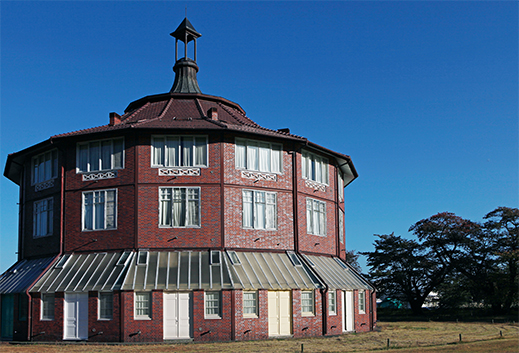 |
|
La Ruche (The Beehive), 1983 reconstruction of the original building by Gustave Eiffel in Montparnasse, Paris. It contains artist studios and a gift shop. |
But the centerpiece of the Kiyoharu complex is La Ruche (The Beehive), a reconstruction of the iconic 16-sided building designed by Eiffel for the 1900 Paris Exposition. The original still survives in Montparnasse, where it hosts ateliers for over 50 artists. Kiyoharu's La Ruche was likewise built to provide live/work studios for visiting artists.
Founded in the early 1980s, the colony was the brainchild of art dealer Chozo Yoshii, who owned galleries in Tokyo and Paris -- hence the French connection. Yoshii noted that there were few places in Japan where artists from overseas could live, work, and exhibit. The site he chose, some two hours west of Tokyo in Yamanashi Prefecture, encircled by the mountains of central Honshu, could not be more beautiful. Accenting its glorious vistas every spring with their blossoms are the massive cherry trees that line the periphery of the former school grounds, planted by local children a century ago.
Tadao Ando, Museum of the Light (2011) |
One of the first facilities Yoshii built on the Kiyoharu site was the Shirakaba Museum, devoted to the work of the Shirakaba-ha, a literary group with whom the gallerist had close ties. Their journal, Shirakaba (White Birch), promoted Western aesthetics in Japanese art and literature. The museum's architect, Yoshio Taniguchi, also designed Kiyoharu's Rouault Chapel, a raw-concrete modernist structure that houses a stained-glass painting and a crucifix by the renowned French artist. A companion to Taniguchi's chapel is Tadao Ando's Museum of the Light, a boxy concrete structure that looks rather forbidding until you walk inside, where strategically placed windows and skylights bathe the works on exhibit in lovely natural light.
Exterior view of the Washin guesthouse and rock garden, designed by Hiroshi Sugimoto and Tomoyuki Sakakida, New Material Research Laboratory (completed in 2019). Photo © Hiroshi Sugimoto / Courtesy of NMRL |
Today the colony is run by Foundation Yoshii, whose director, Hiromi Yoshii, is Chozo's son and the owner of the hiromiyoshii galleries in Tokyo. One of Yoshii's most successful artists, Hiroshi Sugimoto, has recently contributed to the colony's architectural diversity with a stunning new guesthouse named Washin, which might be translated as "Japanese heart." Originally known for his photography, Sugimoto has lately branched out into such endeavors as building design in partnership with architect Tomoyuki Sakakida through their New Material Research Laboratory (NMRL). Made of wood and stone but with a steel frame that supports broad, open sightlines under a copper roof, Washin exemplifies NMRL's trademark use of traditional Japanese materials in the service of contemporary designs that manage to evoke the classic Edo-era sukiya architecture of Kyoto's Katsura Imperial Villa.
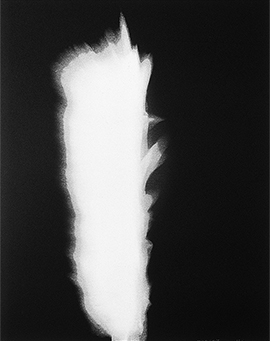 |
|
 |
|
|
|
Hiroshi Sugimoto, In Praise of Shadows (2000) and Kegon Falls (2006), lithographs, © Hiroshi Sugimoto. Courtesy of Gallery Koyanagi and Hiromi Yoshii Edition |
To celebrate the opening of Washin this spring, Kiyoharu Art Colony is exhibiting photographic works by Sugimoto in several venues around the campus. Most can be viewed inside Ando's Museum of the Light, which proves to be the perfect environment for In Praise of Shadows, a series of monochrome lithographs of candle flames. The standout for me, however, was a single print, Kegon Falls, mounted on a traditional kakejiku scroll backing and looking for all the world like a traditional Zen sumi-ink painting.
More of Sugimoto's work adorns the interior of Washin, we are told, but unfortunately the new building is open only to Kiyoharu members, and partially hidden from view by a fence. With a little neck-craning, however, one can get a good look at the building's exterior and its surrounding rock garden, also designed by Sugimoto. Additionally, he designed the interior for Stove, a haute-cuisine restaurant operating in an elegant old Japanese house next door to Washin, and a number of his works are on view there as well.
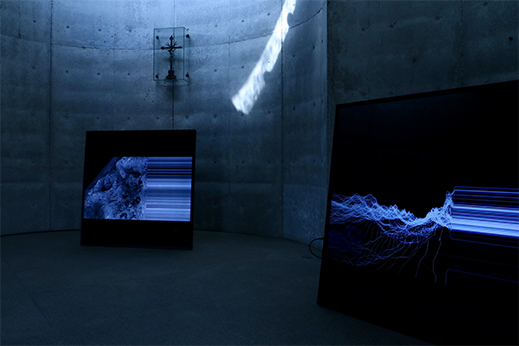 |
|
Akira Wakita, scenery (2019), installation view, Rouault Chapel. Photo © Ken Ishii |
Concurrent with the Sugimoto exhibition, which continues until 30 June, is an installation in the Rouault Chapel by Akira Wakita. Titled scenery, it consists of two large video screens standing on the chapel floor, flanking the crucifix on the wall. Playing across the screens are abstract shifting patterns of light that, while compelling, seem awkwardly at odds with the hushed ambience of the chapel. Wakita describes his installation as an exploration of the question, "What kind of everyday scenery will the human beings of the future see?" The effect is of a juxtaposition of several eras of art and architecture that does not quite jell. Still, mix-and-match experiments of this sort seem to be the Kiyoharu m.o., and even the wierder matchups are never boring.
The entire Kiyoharu experience is gratifyingly serendipitous on so many levels -- the art, the architecture, the scenery -- that there is a fairytale quality to the place. It's a bit like a theme park for lovers of the arts, but its charms can be appreciated by visitors young and old, art mavens or not. Kiyoharu is an easy day trip from Tokyo. Bring the family!
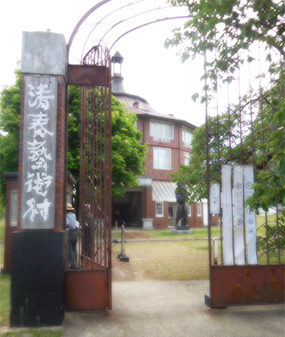 |
|
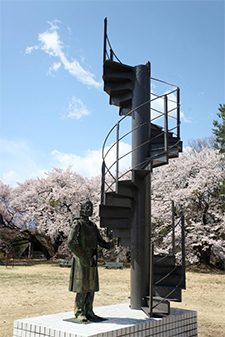 |
|
|
|
|
The entrance to Kiyoharu Art Colony, formerly the gate of Kiyoharu Elementary School. Photo by Alan Gleason
|
|
Original section of the Eiffel Tower staircase (built in 1889; installed at Kiyoharu in 1989), with a sculpture by César, Hommage à Eiffel (c. 1989), welded bronze |
All images courtesy of Foundation Yoshii and Kiyoharu Art Colony. |
 |
| Hiroshi Sugimoto: Washin |
| Akira Wakita: scenery |
| 6 April - 30 June 2019 |
| Kiyoharu Art Colony |
2072 Nakamaru, Nagasaka-cho, Hokuto-shi, Yamanashi Prefecture
Phone: 0551-32-3332
Hours: 10 a.m. to 5 p.m.; admission until 4:30 p.m.
Closed Mondays (or the following day when Monday is a national holiday) and New Year holidays
Access: 5 minutes by taxi, 10 minutes by bus, or 30 minutes on foot from Nagasaka Station on the JR Chuo Line, 2 hours west of Shinjuku Station, Tokyo
|
|
|
|
| |
 |
Alan Gleason
Alan Gleason is a translator, editor and writer based in Tokyo, where he has lived for over 30 years. In addition to writing about the Japanese art scene he has edited and translated works on Japanese theater (from kabuki to the avant-garde) and music (both traditional and contemporary). |
|
|
|
|
|
|
|
|
|
 |
|